Go to Northern India bird tour page | India bird tours | Asian trip reports | All our birding tours
DOWNLOAD TRIP REPORT
26 JANUARY – 12 FEBRUARY 2020
By Dylan Vasapolli
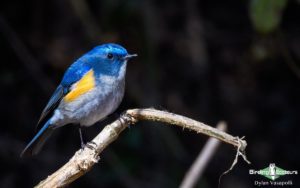 The stunning Himalayan Bluetail is a prized target and showed well on a number of occasions.
The stunning Himalayan Bluetail is a prized target and showed well on a number of occasions.
Overview
This 17-day set-departure tour takes in the best of Northern India, and combines birding and searching for one of India’s, and indeed the world’s, most-prized mammals – the tiger. Beginning in the capital city, New Delhi, the tour visits the diverse Sultanpur National Park on the outskirts of this megacity before moving south to the famous Ranthambhore National Park, where tigers are the main priority. Moving onward Bharatpur with Keoladeo National Park follows suit, as does Agra with the iconic Taj Mahal, before we arrive at the Chambal River. Following an obligatory cruise on the river we travel back to New Delhi and northward into the foothills of the Himalayas. Here we base ourselves in both Sattal and Pangot and explore the surrounding areas. Our last stop is the famous Corbett National Park, where we spend a few days both within and outside the park, searching for the area’s many prized species before we travel back to New Delhi once more, bringing the tour to an end.
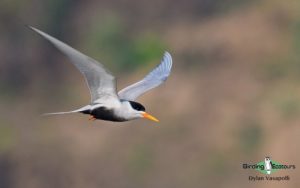
This tour had a small group, with only three participants joining, Betty, Katie, and Ken. The tour went smoothly, with the only hiccup coming from the slight change of plans in the Himalayas with us having to trade a night in Pangot for another night in the Sattal area due to heavy recent snows in Pangot. This did also mean that the weather was on the cool side in this region, but we weren’t impeded in any way. We did well and recorded the vast majority of the area’s prized specials, including some of the most sought-after birds in the world. Some of the trip’s many highlights were Koklass Pheasant, Bar-headed Goose, Himalayan, Red-headed, and Indian Vultures, Eastern Imperial, Greater Spotted, and Indian Spotted Eagles, Brown Crake, River Lapwing, Ibisbill, Painted Sandgrouse, Indian Courser, Black-bellied Tern, Tawny and Brown Fish Owls, Great Hornbill, Great Slaty Woodpecker, Black-headed Jay, Spotted and Slaty-backed Forktails, Himalayan Rubythroat, Grey-crowned Prinia, Chestnut-headed Tesia, Nepal and Scaly-breasted Cupwings, Brown Dipper, Rufous-chinned and White-crested Laughingthrushes, Golden Bush Robin, and Himalayan Bluetail among others. We ended the tour with a total of just over 370 species seen. Mammals are also an important component of this tour, and although the main quarry, Tiger, gave us a bit of a headache, we eventually connected with these stunning cats near the end of the trip. Other highlights were the rare Ganges River Dolphin, Tarai Gray and Nepal Gray Langurs, Common Palm Civet, Golden Jackal, and the expected suite of deer and antelopes, including Northern Red Muntjac, Sambar, Chital, Nilgai, Chinkara, and Himalayan Goral. The impressive Gharial was another major target, and indeed a highlight of the tour, with us fortunately having a number of encounters with these rare reptiles. Full species lists can be found at the end of this report.
Detailed Report
Day 1, January 26, 2020. Arrival in Delhi and birding the Sultanpur surroundings
With the group having all arrived during the previous afternoon and evening, two days ahead of the main tour (starting on the 27th), we met for a sedate breakfast before heading out for the day, which we’d spend as a pre-day around the Sultanpur National Park area as an introduction to birding in the area. As today was Republic Day, the actual national park was jam-packed, so we spent our time away from the crowds, birding in the nearby wetlands, agricultural fields, and dry grasslands. Our morning session was incredibly productive as we walked along a few dirt tracks that skirted some wetlands, but otherwise passed through agricultural fields. One of our early highlights was a mixed group of three Sarus Cranes and four Common Cranes, giving great comparative views as they walked about, before we picked up a small group of the prized Sind Sparrow. The marshes were good and held Bar-headed Goose, Ruddy Shelduck, Indian Spot-billed Duck, Northern Pintail, Grey-headed Swamphen, White-tailed Lapwing, Temminck’s Stint, Green, Marsh, and Wood Sandpipers, Common Redshank, Red-naped Ibis, both Moustached Warbler and Clamorous Reed Warbler, Rosy Pipit, and heaps of Wagtails with the bulk being Citrine but with Western Yellow and White also present. The brushy areas surrounding this held Grey Francolin, Common Hawk-Cuckoo, Eurasian Wryneck, Isabelline Shrike, Graceful, Plain and Ashy Prinias, Lesser Whitethroat, Bluethroat, numbers of the snazzy Indian Robin, and Siberian Stonechat, amongst others. We took a break during lunch, resuming birding afterwards in a different, much drier area. While we saw a number of species that we had seen earlier in the day it was good to acquaint ourselves further with the more regular species, and we did manage to find a few new species as well. We spent some time scouring the open fields and came up trumps with brief Chestnut-bellied Sandgrouse flying away (after being spooked by a flying Eurasian Sparrowhawk), Indian Stone-curlew, Yellow-wattled Lapwing, Ashy-crowned Sparrow-Lark, Greater Short-toed Lark, Crested Lark, Pied and Bank Mynas, Black Redstart, Isabelline and Desert Wheatears, Brown Rock Chat, and Paddyfield and Long-billed Pipits. Having had our fill, we made our way back to our hotel, where we settled in for the evening after a good first day.
Day 2, January 27, 2020. Birding Sultanpur National Park
Starting the official tour today we headed again to the Sultanpur National Park area but spent the bulk of our time inside the reserve. Our morning began with a stop at the Basai Wetlands, where a plethora of birds awaited us in hazy weather conditions. A few Oriental Skylarks greeted us as we climbed out the car before we started scanning for birds. Even though it was a short stop here we picked up nearly 50 species, with waterfowl including Bar-headed Goose, Knob-billed Duck, Northern Shoveler, Gadwall, Northern Pintail, Eurasian Teal, and Ferruginous Duck, a large flock of Greater Flamingos, incredible masses of Grey-headed Swamphens, our first Painted Stork, Grey and Purple Herons, Western Marsh Harrier, and a single Booted Warbler in the surrounding scrub. There weren’t many waders/shorebirds around, but we did see Common, Green, and Wood Sandpipers and Common Snipe along with White-tailed Lapwing. We then moved a short distance to the Sultanpur National Park, where we resumed our mornings birding with a walk around the park until we broke for lunch. The haze was still in effect, with low light conditions, but it soon lifted. We focused on the acacia woodland surrounding the dam and then did a bit of wetland birding from the dams’ edge. The wooded areas kept us busy, and we found the tricky Brooks’s Leaf Warbler early on. Our first woodpecker of the tour was the stunning Black-rumped Flameback, which we then saw a few times during the morning, before we focused on warblers for a bit. We did well to pick up Hume’s Leaf Warbler, Common Chiffchaff, Lesser Whitethroat, and Moustached Warbler in the reeds, while noisy Large Grey Babblers were a pleasant distraction. A number of Red-breasted Flycatchers were present, but sadly we couldn’t turn any of them into Taiga Flycatcher, and a few skulking Bluethroats were also present. We also picked up some more-widespread species, such as Common Kestrel, Common Woodshrike, Rufous Treepie, Common Tailorbird, Indian White-eye, Jungle Babbler, Oriental Magpie-Robin, and the stunning Red Avadavat. A bare tree allowed excellent looks at both Wire-tailed and Streak-throated Swallows.
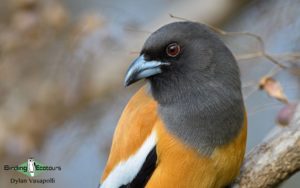
When we moved into the wetlands waterfowl were again present in immense numbers, and it took some time to sift through the throngs of birds present on the water. Greylag Goose was present in low numbers, while the vast majority of species were Northern Shoveler, Gadwall, Northern Pintail, and Eurasian Teal. Among them we also noted Eurasian Wigeon, Indian Spot-billed Duck, Red-crested and Common Pochards, and Ferruginous and Tufted Ducks, along with numbers of Eurasian Coots and Common Moorhens. Waders were few and far between, but a new species was a small group of Ruff. While turning our attention to the larger herons and egrets, a pair of the snazzy Black-necked Stork stole the show, while a small colony of Painted Storks were also present, together with Eurasian Spoonbill, Oriental Darter, Little and Great Cormorants, Great White Pelican, Great, Intermediate, and Little Egrets, and Indian Pond Heron. A few raptors perched atop the trees surrounding the water and gave us some good views – Booted and Eastern Imperial Eagles were noted, as too were a few Western Marsh Harriers. Following our lunch break we searched a nearby stream for Striated Babbler and almost immediately found our target, before continuing and starting with a few of the cute Spotted Owlets. We worked our way through the warblers but couldn’t find any new species, while many of the same waterbirds were present and seen again – allowing us to all get more familiar with them. The same suite of raptors was present as well, until a single Greater Spotted Eagle gave us a wonderful aerial display before moving out of view. A similar suite of species to those seen during the morning and some of the species seen yesterday were seen again during our afternoon spell, with little new, but we did round off our time in the park with a lovely pair of roosting Indian Scops Owls, which proved tricky to spot in their shady enclave. Then we made our way back to our hotel after another fantastic day.
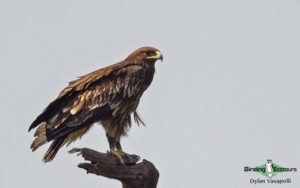
Day 3, January 28, 2020. Transfer from New Delhi to Ranthambhore and afternoon safari
The morning was set aside as a travel day, as we made our way by means of the Golden Temple train from New Delhi to Sawai Madhopur on the outskirts of the famous Ranthambhore National Park. Although our train was slightly delayed, the actual trip itself went smoothly, but it was a bit tight getting to the hotel, having a quick lunch, and then getting ready to board the van that would take us into the park for the afternoon. We were assigned Zone 5 and bumbled our way along the road, stopping occasionally. Although the drive wasn’t to produce our hoped-for Tiger, we had a fairly enjoyable drive filled with quite a few birds, which was better than expected. Numbers of Indian Peafowl littered the ground, while some of the waterbodies held Brown Crake, Common Greenshank, Black, Painted and Woolly-necked Storks, Great Cormorant, Black-headed Ibis, Common Kingfisher, and White-browed Wagtail. Other notable birds seen during the afternoon included Crested Serpent Eagle, Indian Scops Owl, Black-rumped Flameback, Small Minivet, White-browed Fantail, numbers of the comical Rufous Treepie, Grey-headed Canary-flycatcher, Cinereous Tit, Dusky Crag Martin, Hume’s Leaf Warbler, and Black Redstart. In addition to Sambar (a deer) and Chital (Spotted Deer) we found Northern Plains Gray Langur, Wild Boar, and our first Mugger (Marsh Crocodiles). As we had been cooped up in a vehicle for most of the day we were eager to walk around, and once we had returned to our hotel we took a stroll around the area until it got dark. Although things were on the quiet side we did well to see Common Babbler, Ashy Prinia, Pied Myna, and Bay-backed Shrike before we encountered a few unidentified sandgrouse that disappeared into the darkness.
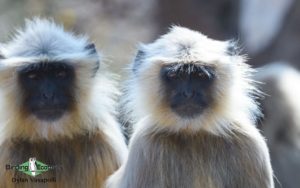
Day 4, January 29, 2020. Full day in Ranthambhore National Park
We were up and ready to go early but had to wait a little while for our van to arrive. Eventually we were all aboard and on our way into Ranthambhore National Park once more. We were assigned Zone 4 for the morning and worked our way through the mosaic of open woodlands, riverine areas, and some more open grassland/scrubland. By and large the morning was relatively quiet, with very limited bird activity, and unfortunately the same was true on the mammal side. We certainly gave it a good go, stopping regularly, scanning around, and listening, but the prized Tiger did not materialize. Some birds seen during the morning were Eurasian Teal, a brief Yellow-footed Green Pigeon, Crested Serpent Eagle, a stunning Brown Fish Owl, White-bellied Drongo, Ashy-crowned Sparrow-Lark, and Grey Wagtail. A similar suite of mammals as had been seen the previous afternoon were seen again this morning. After returning back to our hotel we had a quick bite to eat before heading out to explore the dry scrub surrounding our hotel. In stark contrast to the morning thus area was brimming with birdlife, and we enjoyed a wonderful few hours working it. A small group of the stunning Painted Sandgrouse was a highlight early on and showing well before we found Shikra, Green Bee-eater, Plum-headed Parakeet, Bay-backed Shrike, Brown Rock Chat, and both Rosy and Brahminy Starlings. We then saw an Indian Bush Lark, which gave us saturating views along with a Tawny Pipit, and shortly before returning to the hotel we saw a Rufous-fronted Prinia, which showed well. Another small bite to eat followed before we set off to Ranthambhore once more, this time bound for Zone 10. It was a bit of a drive until we got to the gate, but once we were in we immediately started to track down our major target, the Tiger, which had shown well here during the morning session. We again spent lots of time searching, scanning riverbeds and open forest, and listening, but we had to resign ourselves to not seeing this majestic animal just yet and being content with the fresh tracks were had found along one of the roads. Not to be forgotten, of course, the birding was pretty good here, and we enjoyed Grey Francolin, Black Stork, Indian Vulture, Shikra, Besra, Grey-headed Canary-flycatcher, Yellow-throated Sparrow, and a few White-capped Buntings, among many others. Ruddy Mongoose and Chinkara (Indian Gazelle) joined our ‘normal’ suite of mammals seen, and we also saw Indian Softshell Turtle. We settled in for another good evening, hoping for better luck with Tigers later on during the tour.
Day 5, January 30, 2020. Transfer from Ranthambhore to Bharatpur
With a long travel day ahead of us, as we were to transfer from the Ranthambhore area to Bharatpur, we had to make the most of our time available. So we were out at dawn and walked around the outskirts of our lodge and the surrounding area. We didn’t quite get as far as we wanted to, a testament to the good birding we had as we enjoyed a wide range of species, including some shorebirds, woodland species, and a few open country birds. Our first major highlight was finding a small puddle that was alive with birds. Here we enjoyed views of Common Redshank, Common, Green, and Wood Sandpipers, and Ruff, among others, while the surrounding woods produced Eurasian Wryneck, Hume’s Leaf Warbler, Small Minivet, White-bellied Drongo, and Common and Large Grey Babblers. Numbers of Plum-headed and Alexandrine Parakeets were moving overhead, and while we were able to find perched Plum-headed Parakeets, we had to be content with fly-by views of Alexandrine Parakeet. Arguably our best bird of the morning, and probably the day, would come shortly afterwards as we picked up a small group of the prized (and scarce) Indian Courser. We were elated and enjoyed excellent looks at this species, and some scanning around revealed a total of 10 birds. Also present here were a flock of Ashy-crowned Sparrow-Larks, which also showed well, Greater Short-toed Lark, Tawny Pipit, Great Grey Shrike, and Brahminy Starling before we picked up a single Yellow-footed Green Pigeon, which gave us better looks than we had had before. After checking out of our accommodation we set off, hoping to call in at the Soorwal Lake, but access turned out to be somewhat problematic with our vehicle, and we decided to rather press on and spend some of the afternoon at Keoladeo National Park (formerly known as Bharatpur Bird Sanctuary). Following a long drive we eventually arrived, with a few hours of daylight to spare, and immediately set off on foot to explore some of the closer paths. Despite our limited time we enjoyed a good sampling of what was to come for our full day in the park tomorrow. Arguably our main highlight was a small group of the unpredictable Greater Painted-snipe, but we also enjoyed seeing numbers of Bar-headed Goose, Indian Spot-billed Duck, Spotted Redshank, Woolly-necked Stork, and Eurasian Spoonbill, while the bushes on the outskirts of the water held Oriental Turtle Dove, large numbers of Yellow-footed Green Pigeons, Egyptian Vulture, Booted and Steppe Eagles, Spotted Owlet, White-eared Bulbul, Common Babbler, and Red-breasted Flycatcher, among other more widespread species. A number of Golden Jackals were also seen, wrapping up our day.
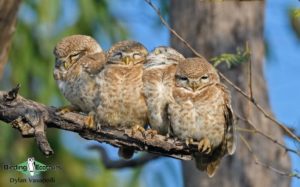
Day 6, January 31, 2020. Full day birding Keoladeo National Park
Following an early breakfast we made our way into the incredible Keoladeo National Park once more, where we would spend the entire day birding around the network of roads and trails going through the various marshes and wooded areas. In short, we had nothing shy of an exceptional day filled with far too many highlights to go through them all. We first explored some of the wooded areas, well away from the water, and after having had our fill here, we made our way into the central reaches of the park and into the wetlands proper – all the while getting around by cycle rickshaws, which offered a great break after a bout of walking. Our morning period went by all too quickly, and we soon found ourselves reminiscing about all the many sightings we had while enjoying our fabulous ‘packed lunch’ in the park, which was a fully catered hot Indian meal. The woods had been quiet in the morning, but we did see Yellow-footed Green Pigeon, Spotted Owlet, Indian Grey Hornbill, Coppersmith and Brown-headed Barbets, Grey-headed Canary-flycatcher, Indian White-eye, Indian Robin, and Yellow-throated Sparrow. The wetlands held immense numbers of birds, with the bulk of the numbers being made up by various ducks, but also present were large numbers of herons, egrets, and coots and smaller numbers of waders. During our first few hours sorting through the many birds we noted Bar-headed Goose, Lesser Whistling Duck, Ruddy Shelduck, Garganey, White-tailed Lapwing, Bronze-winged Jacana, Black-tailed Godwit, Spotted Redshank, Black-necked Stork (including a pair devouring a large fish), Painted Stork, Great White Pelican, a secretive Black Bittern, and Striated Heron.
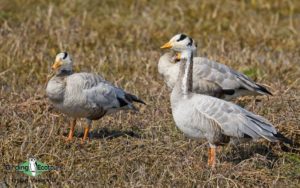
The trees dotted around the wetlands held among others a glorious family of Dusky Eagle-Owls, Bay-backed Shrike, Common Tailorbird, Blyth’s and Clamorous Reed Warblers, Bluethroat, and Red-breasted Flycatcher. Raptors were also well in evidence, and we had to keep an eye on the sky constantly to see all the many raptors moving overhead and occasionally also perching to give us excellent looks. We did extremely well, watching Egyptian Vulture, Crested Serpent Eagle, both Indian Spotted and Greater Spotted Eagles, Booted, Eastern Imperial, Steppe, and Tawny Eagles, and Western Marsh Harrier, with arguably two of the ‘better’ raptors coming in form of a single Himalayan Vulture and a few of the Critically Endangered (IUCN) Indian Vultures. The birding did not slow down in the afternoon, and we continued to work different sections of the wetland and a similar patch of woods during our remaining time in the park. The wetland sections were kind to us, and we were able to find many of the ‘missing’ species we still had, such as Cotton Pygmy Goose, Pheasant-tailed Jacana, and Eurasian Curlew, among others, while a few of the regionally rare Grey-headed Lapwings were a welcome sight. The scrubby trees in the area also finally gave us Eastern Orphean Warbler, and we lucked out with Grey-bellied Cuckoo before ending our day in some wooded areas. A noisy group of Yellow-eyed Babblers and a showy Bluethroat greeted us before our persistence paid off and we found an Orange-headed Thrush that sat for all of us to see. But try as we might, we couldn’t turn any of the Bluethroats hopping around into our hoped-for Siberian Rubythroat. Following our great full day in the park, with over 130 species seen, we settled in for the evening.
Day 7, February 1, 2020. Transfer from Bharatpur to Chambal via the Taj Mahal
Today was one of the most-anticipated days of the tour, as we would be getting to the majestic Taj Mahal. However, our morning began with a journey to the Kumher plains, where we spent the first few hours. We had a productive session walking through the open plains and enjoying many species that we’d only seen once before. These included numbers of the scarce Indian Courser, Indian Roller, Isabelline Shrike, immense flocks of Ashy-crowned Sparrow-Larks and Greater Short-toed Larks, Desert Wheatear, and Yellow-throated Sparrow, while the neat Red Turtle Dove was our only new species. Following breakfast we checked out and traveled to Agra and the Taj Mahal. Visiting this iconic UNESCO World Heritage Site is a must for any traveler, and we enjoyed our time here immensely and were completely enthralled by the beauty, majesty, and history of this incredible site. Following a run-through inside the mausoleum we did a bit of birding along the river. This was productive, and a number of species were present, including our first River Lapwings, but also seen here were Bar-headed Goose, Ruddy Shelduck, Whiskered Tern, Painted and Woolly-necked Storks, Great White Pelican, Egyptian Vulture, Common Chiffchaff, and Red-breasted Flycatcher. Then we proceeded to our accommodation, Chambal Safari Lodge, where we arrived in the late afternoon. After checking into our rooms we took a short walk around the grounds and the surrounding area and found our main quarry, Brown Hawk-Owl, fairly easily early on. After having had our fill of the bird we stopped for a nearby pair of Indian Scops Owl (nearly in the same view as the hawk-owl) before resuming our walk, which was enjoyable, but we didn’t pick up many new species. Rather we enjoyed some we had only seen a few times, such as Lesser Whistling and Knob-billed Ducks, Yellow-wattled Lapwing, Indian Stone-curlew, and Coppersmith Barbet, among others. Following a great dinner, we went on a short night walk, trying to see if we could find any nocturnal mammals. After a concerted effort we eventually found a Common Palm Civet and also enjoyed Indian Hare on our walk.
Day 8, February 2, 2020. Morning birding the Chambal River, transfer to New Delhi
We made our way to the National Chambal Sanctuary at pre-dawn, arrived at day break, and set out for a walk through the dry acacia scrub and grass before continuing our way to the Chambal River, where we would take a boat cruise. It was a fairly busy morning with quite a few birds moving around, with the top highlights being a vocal Sulphur-bellied Warbler, families of Grey-breasted Prinia, a large group of White-capped Buntings, and a plethora of Babblers – namely Jungle, Large Grey, Common, and Yellow-eyed, among others. It had been a pretty clear morning with no fog, but that all changed during our walk, as thick fog rolled in somewhat surprisingly. At the river we enjoyed our breakfast and a hot cup of chai before the fog lifted just as suddenly as it had arrived, and we boarded our boat. Due to the high level of water in the river this season one of our prime targets, Indian Skimmer, had moved far downstream and was largely inaccessible, requiring a multi-hour trip one-way to reach the site – sadly out of reach for our morning cruise. We spent several hours on the water and enjoyed a wonderful boat trip while finding many of our other targets. Some of the top birds seen included a few of the scarce and prized Black-bellied Tern, a large flock of Chestnut-bellied Sandgrouse, Great Stone-curlew (Thick-knee), River Tern, Pallas’s Gull, close views of River Lapwing, Bonelli’s Eagle, Long-legged Buzzard, Sand Lark, and Blue Rock Thrush. Our biggest target, however, was the incredible Gharial, and we weren’t to be disappointed, enjoying many views of these immense and fascinating reptiles. Ganges River Dolphin also obliged, much to our pleasure, and we spent some time enjoying views of this rare mammal as well! A wide range of bird species we had seen multiple times on the trip already was noted as well, along with several Muggers (Marsh Crocodiles) and Indian Softshell Turtle. Returning to shore, feeling very satisfied, we slowly made our way back to the lodge making a few birding stops, which delivered among others a few Baya Weavers. We had lunch, checked out, and drove back to New Delhi, arriving in the early evening, brimming with excitement for what the next leg of the trip would entail – the Himalayan zone.
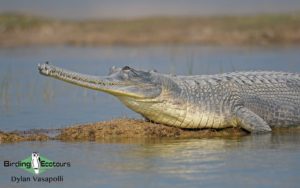
Day 9, February 3, 2020. Transfer from New Delhi to Bhimtal
Today was effectively a travel day as we made the long transfer from New Delhi to our base for the next few nights in Bhimtal. Our travel was hindered by dense fog (clearing only after 11 a.m.) and many slow-going vehicles as a result of this. We eventually arrived at our birding area in the mid-afternoon and immediately started birding. The next few hours went by in a blur of excitement filled with new birds. Our first vigil for Spotted Forktail produced the goods, with excellent looks at a pair moving up and down along the stream, and our time here also produced Great Barbet, Blue Whistling Thrush, Grey-winged Blackbird, Yellow-bellied Fantail, Brown-fronted Woodpecker, Himalayan Black-lored Tit, Slaty-blue Flycatcher, White-capped Redstart, Plumbeous Water Redstart, and a brief Rufous-bellied Niltava that disappeared a bit too quickly for our liking. A shrill call coming from the undergrowth belonged to Scaly-breasted Cupwing, and we were treated to brief looks at this tiny bird as it hopped and moved around in the undergrowth before melting back into the scrub. A bird party a bit farther along held Green-backed Tit, Mountain Bulbul, Whistler’s and Grey-hooded Warblers, Whiskered Yuhina, and Black-chinned Babbler, while a magnificent blue spot belonged to a Small Niltava which showed well. A bit farther along the stream we did well to pick up Slaty-backed Forktail and enjoyed good comparative views as it foraged alongside its larger Spotted Forktail cousin. We took a short drive to another area, where our search for Brown Dipper was a success; we picked up a pair moving about and enjoyed good scope views of this prized bird. The large Crested Kingfisher soon flew into view, and as if that wasn’t enough our day was rounded off with close looks at Aberrant Bush Warbler. Following a great end to a rather long day we settled in for the evening, looking forward to our full day in the area tomorrow.
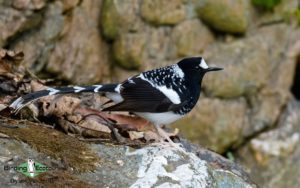
Day 10, February 4, 2020. Full day birding Sattal and surroundings
Following our pre-dawn coffee and cookies we loaded the van and headed to the Sattal area, where we would spend the morning. Our first stop was on the outskirts of the village, where we tried for Himalayan Rubythroat. We worked a few patches, and fortunately it didn’t require too much effort and we soon located our target, and, although it took some patience to ensure that we all got good looks at this prized and awesome bird, we were successful. Then we encountered our first bird party, which included Streaked Laughingthrush, the snazzy Black-throated Bushtit, Rufous-bellied Niltava, Yellow-breasted Greenfinch, Olive-backed Pipit, and our first of many Grey-hooded Warblers for the day. We worked the outskirts of the village for a short time longer, finding Kalij Pheasant, numbers of Slaty-headed Parakeets, Asian Barred Owlet, Grey-backed Shrike, Chestnut-bellied Rock Thrush, Green-tailed Sunbird, and one of our early highlights, a few of the dapper Red-billed Leiothrix. After a breakfast break we soon found ourselves in a haze of activity, with species seen including Speckled Piculet, Brown-fronted Woodpecker, White-throated Fantail, Grey Treepie, Lemon-rumped Warbler, Rufous Sibia, Blue-winged Minla, Chestnut-bellied Nuthatch, Bar-tailed Treecreeper, the prized Himalayan Bluetail, and Common Rosefinch. The good birding didn’t stop, and we continued from strength to strength, progressing to one of the dams in the valley, which produced further species including Greater Yellownape, Greater Flameback, Grey-headed Woodpecker, Red-billed Blue Magpie, Himalayan Prinia, brief looks at the secretive Grey-sided Bush Warbler, Rusty-cheeked Scimitar Babbler, White-throated Laughingthrush, Velvet-fronted Nuthatch, Tickell’s Thrush, numbers of Grey-winged Blackbirds, the stunning Rufous-gorgeted Flycatcher, and Russet Sparrow. Two of the best species seen in this last morning session were the rare and declining Grey-crowned Prinia, which was slowly seen working its way through the scrub thickets, and the rather exceptional Chestnut-headed Tesia, which played hard to get, but after hearing it for some time we were finally rewarded when the bird hopped out onto the edge of the stream, giving most of us good views. We then broke for lunch and afterwards resumed birding, as we transferred to another area, higher up in the mountains. Our afternoon was sadly not nearly as productive as the morning session had been, as a cold wind, cloud cover, and generally poor conditions all conspired against us, resulting in a tough afternoon session. Although we were able to locate a large Striated Laughingthrush and a brief Mountain Hawk-Eagle that disappeared a bit too quickly, these were virtually the only species we could show for our efforts.
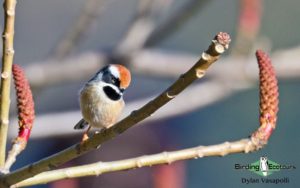
Day 11, February 5, 2020. Full day birding Bhimtal and surroundings
We had a slight change of plans, as we were supposed to be heading up to Pangot today, but with some recent heavy snowfall, access to the area was difficult, and we opted to extend our stay in the lower elevation area around Bhimtal/Sattal for one more night, meaning we had another full day at our disposal there. We spent the morning birding in and around one of the outlying villages with its mosaic of fruit trees and mix of some alpine and riverine vegetation. Right from the onset the birding was good, and so it continued for most of the morning. First was a stunning male White-collared Blackbird perched near the road, and a feeding group soon after consisted of Himalayan and Grey-headed Woodpeckers, Maroon Oriole, Red-billed Blue Magpie, Grey Treepie, Green-backed Tit, Lemon-rumped Warbler, Black-throated Bushtit, Rusty-cheeked Scimitar Babbler, Striated and many Streaked Laughingthrushes, Rufous Sibia, Grey-winged Blackbird, Chestnut-bellied Rock Thrush, Green-tailed Sunbird, and Rock Bunting. We spent some time working through the group to ensure we all got onto the birds. We eventually tore ourselves away, continued a bit farther, and paused to search some seeding trees, which turned up a large flock of European Goldfinches along with Yellow-breasted Greenfinch, White-tailed Nuthatch, Rufous-bellied Niltava, and arguably one of the best sightings of the morning, and indeed the day, a Rufous-chinned Laughingthrush seen feeding on the ground a short distance away for some time. Small stops here and there produced further species, such as Asian Barred Owlet, Slaty-headed Parakeet, some surprise Himalayan Shrike-Babblers, Red-billed Leiothrix, Black-throated Thrush, Blue-fronted Redstart, and another top contender for bird of the morning/day, a sharp-looking male Himalayan Bluetail, which showed wonderfully to all of us. Satisfied with the morning we made our way back to our hotel, arriving around midday. Following lunch and a break we resumed our birding in the mid-afternoon, heading to the Chaafi area, where we had started our Himalayan birding a few days ago. While we saw a similar suite of species to those seen on our first afternoon in the area (day 9), we also found a number of different species. A mixed group of woodpeckers was an early highlight, consisting of Greater and Lesser Yellownape and Grey-headed, Brown-fronted, and the snazzy Rufous-bellied Woodpeckers.
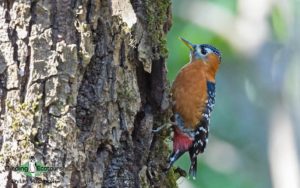
We enjoyed more excellent looks at Spotted and Slaty-backed Forktails and bettered our views of the secretive Scaly-breasted Cupwing. We worked hard for Golden Bush Robin, but despite our best efforts we couldn’t lure an individual out into the open and had to be content with hearing the bird. Other species of interest seen during our afternoon included Crested Kingfisher, Grey-capped Pygmy Woodpecker, Aberrant Bush Warbler, Brown Dipper, Rufous-gorgeted Flycatcher, and Crimson Sunbird. We retired to another good meal, ready for the next few days’ adventure.
Day 12, February 6. Transfer from Bhimtal to Pangot, birding en-route
Following an early checkout we made our way to the Sattal area, where our first port of call was one of the hides in the area, where we would target a few birds. It was an eventful morning in the hide, and although we only spent a relatively short span of time there was never a dull moment. One of our big targets, White-crested Laughingthrush, didn’t keep us waiting for too long, and we enjoyed some excellent looks at this attractive bird, as a small group of them fed together with a massive party of White-throated Laughingthrushes. A Common Green Magpie that spent some time at the hide was a treat, as were getting prolonged and close looks at Great Barbet, Grey-headed Woodpecker, Grey Treepie, Kalij Pheasant, Red Junglefowl, and Red-billed Leiothrix. After we tore ourselves away from the hide we spent the morning birding some of the surrounding forested areas, which for the most part gave us a similar suite of species we had been seeing over the last few days. A large flock of Black-headed Jays and a brief Common Emerald Dove were the only new species, but we did better our views of other species, such as Blue-winged Minla and Rufous-chinned Laughingthrush. We then made some ground to the Nainital area, where we had our next birding stop, which was incredibly productive. Open scrub areas yielded Blue-capped Redstart, a small flock of Pink-browed Rosefinches, Plain Mountain Finch, and a number of Rock Buntings, while the more wooded/forested areas including watching a garbage dump was brimming with birds, with the highlights going to a large group of the snazzy Chestnut-crowned Laughingthrush.
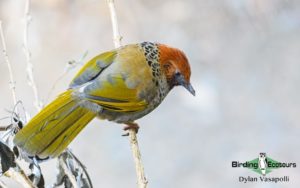
We also had excellent sightings of Mountain Hawk-Eagle (including an adult bird trying to catch a squirrel right in front of us!), Himalayan Bluetail, Rusty-cheeked Scimitar Babbler, and a few Chestnut Thrushes intermingled with a mixed group of Grey-winged and White-collared Blackbirds. We also finally found Buff-barred Warbler, and once the first bird was out of the way, as is so typical, the flood-gates opened and we saw many more. Then we continued to Pangot, changing vehicles to a jeep from our larger van, as the latter was unable to drive the road into Pangot due to all the recent snow. Misty conditions were the order for the rest of the afternoon, and we didn’t see much but enjoyed close looks at Himalayan Woodpecker, further views of Chestnut Thrush, and the prized Golden Bush Robin. We settled in for a cool evening at elevation.
Day 13, February 7, 2020. Full day birding Pangot and surroundings
Following an early chai and biscuits we set off pre-dawn to the Vinayak area, where pheasants would be the main target of the day. As we slowly wound our way higher up we paused at sunrise to admire the peaks of the distant Himalayas before continuing onward. Our first target would be Koklass Pheasant, and it took some searching, but quite literally at the farthest point we could reach, due to the recent snowfall, we bumped into a group of four individuals, which, after scurrying away initially, settled down and gave us some great views! We then made our way to ‘Cheer Point’, where Cheer Pheasant would be the order for the remainder of the morning. We spent some time scanning the steep grassy slopes but in the end were unsuccessful. Other birds seen in the area included a few eye-level Himalayan Vultures, Black Eagle, Mountain Hawk-Eagle, a large flock of Altai Accentors, Blue-capped Redstart, and a few stunning Himalayan Bluetails. Hill Partridge frustrated us by remaining unseen. Our morning was rounded off by a visit to a village area and its surrounding terraced fields, which were a bit quiet but did yield Mistle Thrush and brief Black-throated and Rufous-breasted Accentors, among others. Himalayan Goral, Northern Red Muntjac, Sambar, and Wild Boar were all seen during the course of the morning. We then made our way back to our lodge to break for lunch before resuming birding in the midafternoon, visiting another area nearby. Here we slowly walked the roads, passing through patches of open land and some forested areas. The weather wasn’t fantastic, similar to the previous day, but we persisted and enjoyed some good birding as we worked the area. Another low flyby of a Mountain Hawk-Eagle was appreciated, while an Asian Barred Owlet sat up in the open for all to admire. We also finally connected with the handsome Scaly-bellied Woodpecker, while Coal Tit played hide-and-seek with us, vanishing before we could all get good views. A pair of Dark-breasted Rosefinches was the last new species for us. Other species we found included Himalayan Woodpecker, Maroon Oriole, Eurasian Jay, Red-billed Blue Magpie, Himalayan Black-lored Tit, White-tailed Nuthatch, White-collared Blackbird, Blue-fronted Redstart, Rock Bunting, and improved views of Altai Accentor. A dinner in front of the fireplace rounded off another good day in the mountains.
Day 14, February 8, 2020. Birding Pangot and transfer to Corbett
With the morning available to us we set off once more to the Vinayak area, where Cheer Pheasant would be our main focus for the morning. We arrived in good time as the first rays of sun began to appear over the mountains and spent a while scanning the steep grassy slopes of the Cheer Point area. We were sadly unsuccessful once again, but two stunning Yellow-throated Martens bounding away through the grass were the undoubted highlight. Birding some of these higher forests was on the quiet side, but we did run into a group of Yellow-browed and Coal Tits, and also successfully connected with Green Shrike-babbler. Then we made our way back to Pangot, where we gathered our things, checked out, and headed off to bird some of the forested areas farther down the road. Although we didn’t have much time available we did well, finding a large group of Black-faced Warblers along with enjoying stunning views of Rufous-bellied Woodpecker, Eurasian Jay, and Spotted Forktail.
A quick stop in the scrub near Nainital was alive with birds, providing Tickell’s Leaf Warbler, a brief Golden Bush Robin, Common Rosefinch, and numbers of Rock Buntings, while Himalayan Vulture, Himalayan Buzzard, and Peregrine Falcon worked the skies above. Following a smooth transfer we found ourselves in the Corbett area in good time and immediately set off for the Kosi River, where monotypic birds would be the order of the afternoon, with both the prized Ibisbill and Wallcreeper on offer. We started trying to find the former and couldn’t believe our luck when we found a stunning Ibisbill working the river, fairly close to us, very soon after we had arrived!
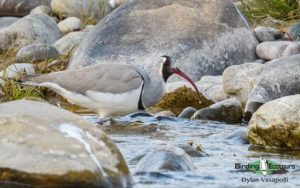
We spent a long time enjoying this spectacular bird, getting stunning views, before beginning to pay attention to some of the other birds in the area as well. The likes of River Lapwing, Crested Kingfisher, Red-breasted Parakeet, Taiga Flycatcher, Grey-breasted Prinia, and Olive-backed Pipit, among others, were all present. But despite a lot of searching we had to go empty-handed on the Wallcreeper side, eventually calling it a day with the sun going down and the temperature beginning to drop. Still, we felt very accomplished about finding what is one of the world’s most sought-after birds and excited at our prospects of going into Jim Corbett National Park tomorrow!
Day 15, February 9, 2020. Jim Corbett National Park
One of our most-anticipated days of the tour had arrived – with us due to enter Jim Corbett National Park. The Dhikala zone of thee park only opened a bit later in the morning, but following an early breakfast we headed out birding and focused on an area similar to where we had been yesterday on the Kosi River. It was a cold morning, and evidently the birds thought so too, with not much happening on the riverside or in the surrounding woods. We eventually found a mixed flock or two and spent a while sifting through them, picking up a few new species such as Long-tailed Minivet and Fulvous-breasted Woodpecker, but otherwise enjoying birds we had seen on the trip already, such as Black-chinned Babbler, Whistler’s Warbler, and Velvet-fronted Nuthatch. The river was particularly quiet, perhaps due to the many locals frequenting its banks, and soon we cut our losses here and headed onward, closer to the gate, for another spell of birding. This proved a good move with a hive of activity keeping us going until we were allowed into the park. Red-breasted Parakeet showed well early on before we found a nice mixed flock, which held Scarlet Minivet, Maroon Oriole, Hair-crested Drongo, and a mass of woodpeckers, including Grey-capped Pygmy Woodpecker, Fulvous-breasted and Streak-throated Woodpeckers, Black-rumped and Greater Flamebacks, and Greater Yellownape. Finally in the park itself we made our way to the Dhikala Camp, slowly birding. The birding was pretty good, and we encountered a number of mixed flocks on the trip along with a few other species here and there, and by the time we had checked into the Dhikala Camp around lunchtime we had enjoyed the likes of Crested Treeswift, the Critically Endangered Red-headed Vulture, both Pallas’s and Grey-headed Fish Eagles, Lineated Barbet, the dainty Collared Falconet perched close to the road, many more Scarlet and Long-tailed Minivets, Bar-winged Flycatcher-shrike, Lesser Racket-tailed Drongo, and Rufous-bellied Niltava, among others.
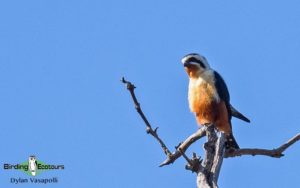
Our afternoon safari saw us crossing the Ramganga River as we headed out in search of a family of Tigers that had been showing well recently. While the afternoon was focused on the Tigers we of course didn’t forget the birds and enjoyed some good birding and excellent birds throughout the afternoon. Sadly our poor run of luck with the Tiger would continue, as none were seen during the afternoon by us or any of the other groups. The birding, however, somewhat compensated for this, with the likes of repeat views of Red Junglefowl and Kalij Pheasant showing well, while a Lesser Coucal played hide-and-seek with us at the base of a grass clump, only showing for some of the group. Glancing at the skies every so often also paid off and produced White-rumped Spinetail and Himalayan Swiftlet along with another Red-headed Vulture. We found a well-camouflaged Jungle Owlet perched in some riverine trees and also enjoyed our first Blue-throated Barbet and Black-hooded Oriole. Ashy Bulbul kept to the thickets, only giving us some brief views, and our last sighting of the day came with a brief flyby of the massive Great Slaty Woodpecker, which left us wanting more. But we didn’t have to worry because after rounding a bend we enjoyed a group of these massive, noisy woodpeckers perched and displaying in an open tree some distance away, before all flying over us, giving us some great views! Our non-avian highlights for the day were Golden Jackal, Northern Red Muntjac, and repeat views of the scarce (and awesome) Gharial!
Day 16, February 10, 2020. Morning in Corbett, afternoon birding Kumeriya
Our morning safari in the Dhikala zone of Corbett began with early mist over the Ramganga River, which made for an atmospheric scene as we set off. Tiger would be our main target for the morning, and we headed in the same direction as on the previous day, trying our luck once more. An early highlight was a stunning male Hen Harrier seen quartering over the grass before we got wind of the first Tiger sighting and headed off. We joined a number of other jeeps staking out a crossing where the Tigers had just been seen, but soon headed a slight bit farther to wait it out. After a short wait the cry of “Tiger” went out as we picked up one of these stunning cats walking through the long grass. Not all of us managed to see it, but some reshuffling and repositioning saw the remainder of the group also getting sight of this most-prized of mammals. We enjoyed some great, albeit brief, close views of at least two of these cats (probably two of the three large cubs present with a female in the area) as they strolled by in the grass close to the track. There was a bit of frustration with all the jeeps moving positions and jostling around, and we ultimately missed the cats crossing the road, but we were well pleased with finally laying eyes on a Tiger! We spent a little while longer, waiting for one to reappear, but this was in vain. While walking through the grass one of the Tigers flushed a Black Francolin, which left us wanting a bit more, and an unidentified buttonquail also disappeared into the grass in front of one of the cats. We could finally concentrate a bit more on some of the birds, and our trip back to the lodge yielded Lesser Fish Eagle, Changeable Hawk-Eagle, Brown Crake, and Streak-throated Woodpecker, among others. We had a quick bite to eat and some chai before venturing off to another patch of Dhikala, where we would spend the rest of our allotted safari time. It was beginning to get quiet, and the birding was slow, but we enjoyed a nesting family of Pallas’s Fish Eagles, some close River Tern flybys, and a flock of the noisy Yellow-eyed Babblers. Following our checkout we took a leisurely stroll around the lodge grounds, enjoying the Gharials once more, along with Black-necked Stork, Western Osprey, a close Lesser Fish Eagle, Black-throated Thrush, and Red-breasted Flycatcher before making our way out of the park. We had some ground to cover and not much time to do it, so we made only a few stops. Two of them, however, gave us a stunning male Great Hornbill perched in the open and a fabulous Tawny Fish Owl. Eventually we found ourselves leaving Corbett National Park and progressed to our lodge, where we dropped our things off and had a quick lunch before heading to the Kumeriya area, where we would spend the rest of the day.
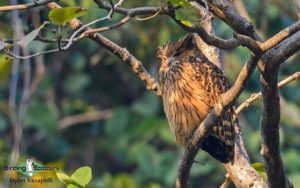
After arriving in the area we found ourselves in a bird feeding party with Grey-headed Woodpecker, White-throated and Yellow-bellied Fantails, Grey-hooded Warbler, and Cinereous Tit among others present. Brown Fish Owl gave us some excitement before we spent a while searching for Orange-bellied Leafbird, and almost as we had given up heard one calling bird but just could not find it. We walked a little farther, enjoying another stunning Tawny Fish Owl, before the leafbird started calling again, this time from much closer, and a quick change of position allowed us to enjoy good looks at this attractive species! As if that weren’t enough, we then heard a calling Nepal Cupwing (Wren-babbler), but it soon went quiet. After a while, though, we heard another one calling from the other side of the river. Fortunately the river was reasonably narrow, so we went to the edge of the water and attempted to call one out of the bushes. It took some patience and careful scanning of the rocks at the base of the bushes, but we eventually enjoyed some good, albeit, brief looks at this prized bird as it bounded along the rocks. A great sighting to cap off a wonderful, successful day!
Day 17, February 11, 2020. Morning birding Corbett, transfer to Delhi
Today was a pretty full day for us, which started early with a morning safari in the Bijrani zone of Jim Corbett National Park. After completing all formalities we were eventually able to enter into the park soon after dawn and started slowly working our way along some of the tracks, birding as we went. It was generally a quiet morning with only a few bouts of activity, but we were still able to add a few new birds to our list, which included a good sighting of the large Stork-billed Kingfisher, a massive flock of over 30 Large Woodshrikes, finally finding Common Iora, and seeing Large Cuckooshrike amid a bird party. In addition we also enjoyed many of the species we had seen already, with Red Junglefowl, Indian Peafowl, Black Stork, up-close-and-personal Changeable Hawk-Eagle, Fulvous-breasted Woodpecker, White-bellied and Hair-crested Drongos, Common Woodshrike, and Velvet-fronted Nuthatch giving us good views. We returned to the lodge, where we had a good, hearty brunch before starting a short walk around the property and the nearby Kosi River. The area full of birds, and we enjoyed a fruitful walk with River Lapwing, Crested Kingfisher, Black Bulbul, Common Chiffchaff, Sykes’s Warbler, Black-throated Thrush, Verditer Flycatcher, and a stunning male Crimson Sunbird before checking out. We also said our goodbyes to Katie, who would be staying behind and continuing on her own, while the remainder of the group transited back to Delhi, where the tour would conclude. Before we got going, though, we called in at the Kosi River Barrage, where we would have one last try for Wallcreeper (after having missed it at its other known areas a few times already), but despite working the area extensively over the next hour luck was not on our side. All was not lost, however, as we enjoyed a large group of Ruddy Shelducks, Woolly-necked Stork, Booted Eagle, Nepal House Martins flying overhead, and a few of the snazzy White-capped Redstarts, among others. Our drive back to Delhi went smoothly enough, with Bronze-winged Jacana being the only notable bird seen, and we arrived at our hotel after dark and settled in for the evening.
Day 18, February 12, 2020. Departure
We met for a leisurely breakfast, reminiscing about the tour and the many great birds seen throughout, and some of our highlights before we said our goodbyes and parted ways, departing at various times throughout the day.
I just want to thank the group for joining the tour, and for being excellent clients that made the trip all the more enjoyable and the birding a delight! Overall we did have a successful tour, filled with far too many highlights to list, but some of them included our close and prolonged views of Ibisbill, eventually laying our eyes on a Tiger, our vast tally of the region’s woodpecker species, and a thoroughly enjoyable river cruise on the Chambal River, which produced our much-wanted Gharial and some great looks at the rare Ganges River Dolphin, among others!
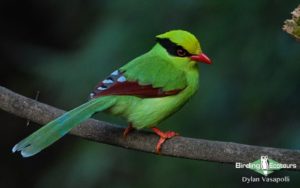
Please see the downloadable PDF above with the full species lists included.